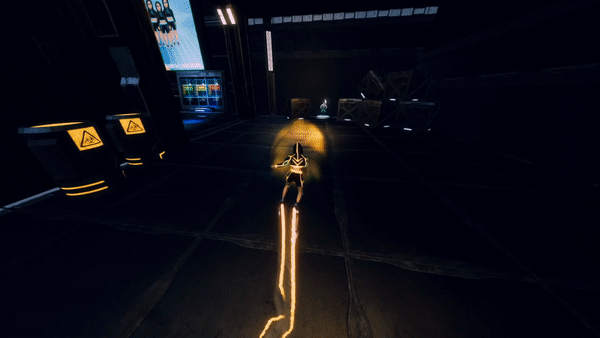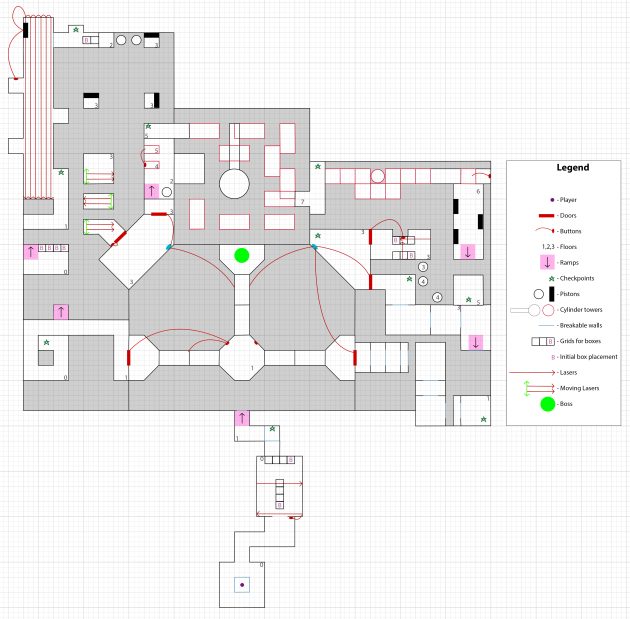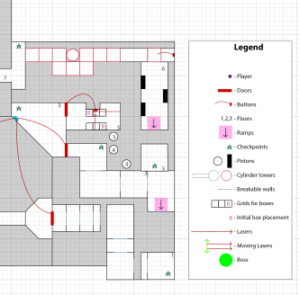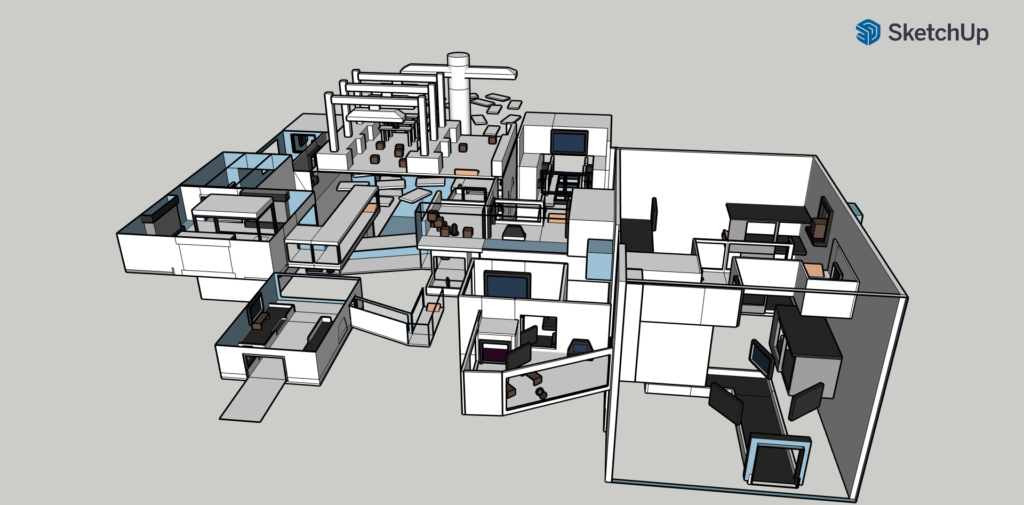Project Momentum
Project Momentum is a 3D platformer in which the player controls a clone that has awaken from its pod. The player must run through a clone producing facility while avoiding multiple traps and obstacles. Once at the final boss, “The Overseer”, the player must take it out to set free all of their fellow clones and escape the factory.

General Information
- Genre: 3D Platformer
- Engine: Unity 2020.1.2f1
- Development Time: 3 months
- Team Size: 20 students
- Designer Team Size: 7 students designers
- Platform: PC
Goal of the project
Simulate a game production in the industry and create a game in a Beta state in a 3 months period.
My task
Design and create the last section of the game with memorable game moments and story points.
My responsibilities
As a Level Designer, I was responsible for:
- Designing the last area of the game.
- Greyboxing the last area of the game.
- Place the art asset in the area.
- Create the lighting in the last area.
- Place the scripted gameplay assets and triggers in the last area of the game.
- Prepare internal playtest for the team and assessed feedback.
- Creating an asset list with priorities to the Lead Artist with blockmesh prototype assets with dimensions.
Design intents
The Lead Game Designer instructed the Level Designers to create areas where the player will feel the need to utilize the running fast mechanic in a simple and fun manner. We were also asked to integrate in the level design some story elements such as “The Overseer” that over looks the progress of the player through out the game and some environment story in the design.
A bonus challenge was to give to the player alternate paths or path choices in the level while keeping the linear gameplay.
Knowing I was designing the last area of the game, I wanted to create a section that would contrast the previous and the next one. The other areas were very large in scale and wide open area. Making the last area more divided and less open helped vary the environment, the gameplay experience and to bring the story of the game to a climax.

Map Layout
First Pass of the Map Design of the Game.

The game was initially develop as a Puzzle-Platformer in a Cyberpunk setting. The player would be able to platform and solve puzzle around the map while using a Boost ability that will give him the ability to reach higher platform and the power to move or break certain objects in the game in order to solve the puzzles.
The two other level designers and I designed the game in 5 areas.
The first one would be the start of the game and introduce the core gameplay elements such as the Boost ability, breaking glass walls, opening doors, avoiding lasers and using ramps to perform a long jump. This section was design to be a short tutorial area that can be completed very rapidly.
The second area is considered as the Hub since it is the room that connects all the areas together and it is also the room of the final Boss.
The third section is the first heavy platforming area. The player has to platform his way through the large area and activate a button that will open a door leading to the next area.
The fourth area is a transition area that introduce a new mechanic that pushes the player to use the Boost ability with some precise jumping.
The fifth area is the last section that will lead the player back to the second area (the Hub) in order to defeat the boss. This area was designed to be the puzzle section of the game. The player must observe his surroundings and use the Boost ability precisely in order to avoid traps and solve puzzles in order to progress trough the area.
My goal in designing this area was to present to the player some simple puzzles that could be solved by performing one action or two. The puzzles needed to be solved quickly since the general pacing of the game is quite fast and the main ability of the player is to go fast. I tried to utilize most of the traps in the game once more, but in a new challenging and puzzle fashion. Near the end of the area, I placed a succession of the same trap (the glass walls) that would display messages addressed to the player bringing the story to a climax just before the player fights the Boss in the next room.

First Playtest
Near the end of the second month of production, we were able to do a first playtest among our development team. Overall, the playtesters enjoyed the platforming segments and using the continuously the Boost ability, but despised having to stop their momentum in order to solve puzzles.
After analyzing the comments of the playtest with the Leads and game designer, the game then became simply a 3D platformer. Since the last area that I designed was heavily inspired to be the puzzle section of the game I had to modify it to make it more into a platformer.
One month left in development for the project, I have decided to start a new design of the area where the player could use the Boost ability for a long period of time without stopping.
Second pass on the Map layout of my level

One month left of production, I started to redesign a new layout where the player could use the Boost ability in a more linear fashion without having to stop their momentum. I kept the concept of the area being more Cube-like as to help the player make some quick decisions and to better utilize the space and use it to my advantage.
In 3 weeks, I was able to create and prototype a new map that reflected the direction of the project by having some platforming elements, paths choices and a few instances of story telling. In the last week, I focused on the lighting, coding trigger events and polishing the area.
Overall, the new redesign of the area fits well the vision of the game and gave some great and unique game moments to the player.